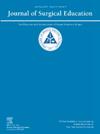Does De-Escalation of Axillary Surgery Impact Surgical Trainee Experience? A 15-Year Institutional Analysis of General Surgery Resident and Breast Surgical Oncology Fellow Operative Volumes
IF 2.1
3区 医学
Q1 EDUCATION, SCIENTIFIC DISCIPLINES
引用次数: 0
Abstract
Objective
To assess the impact of axillary surgery de-escalation trends on general surgery resident and breast surgical oncology fellow exposure to axillary lymph node dissection cases.
Design
Accreditation Council for Graduate Medical Education case logs were retrospectively analyzed with attention to change over time. Trends in axillary lymph node dissection were evaluated using univariate linear regression.
Setting
Academic, tertiary medical center with a large general surgery residency and multiple surgical fellowship programs.
Participants
General surgery residents and breast surgical oncology fellows graduating from 2009-2024.
Results
Axillary lymph node dissection experience is decreasing for general surgery residents (estimate -0.46 cases per resident/graduation year, 95% CI -0.73, -0.19; p = 0.0011), with a mean of 12.0 cases per resident graduating in 2010 versus 6.1 cases in those graduating in 2024. Sentinel lymph node experience is preserved. Fellow axillary lymph node dissection experience is stable (p = 0.20) with a mean of 21.3 cases, however more recent fellow graduates have total numbers less than 20 cases.
Conclusions
The decrease in use of axillary lymph node dissection in clinical practice parallels a decline in resident experience with axillary lymph node dissection while fellow experience appears preserved. Continued attention to trends along with intentional case assignment and alternate/supplemental methods of education, such as video and simulation, may be valuable to educate residents on axillary lymph node dissection.
腋窝手术的降级会影响外科实习生的经验吗?15年普外科住院医师和乳腺肿瘤外科医师的机构分析
目的探讨腋窝手术降级趋势对普通外科住院医师和乳腺外科肿瘤科同行接触腋窝淋巴结清扫病例的影响。对研究生医学教育设计认证委员会的病例日志进行回顾性分析,关注其随时间的变化。使用单变量线性回归评估腋窝淋巴结清扫的趋势。学术,三级医疗中心,拥有大型普通外科住院医师和多个外科奖学金项目。参与者:2009-2024年毕业的普通外科住院医师和乳腺外科肿瘤学研究员。结果普通外科住院医师的淋巴结清扫经历正在减少(估计每住院医师/毕业年-0.46例,95% CI -0.73, -0.19; p = 0.0011),2010年平均每住院医师12.0例,2024年平均每住院医师6.1例。前哨淋巴结经验被保留。腋窝淋巴结清扫经验稳定(p = 0.20),平均21.3例,但最近的毕业生总数不到20例。结论临床实践中腋窝淋巴结清扫术使用的减少与住院医师腋窝淋巴结清扫术经验的减少相一致,而其他经验则保持不变。持续关注趋势以及有意的病例分配和替代/补充教育方法,如视频和模拟,可能对住院医生进行腋窝淋巴结清扫的教育是有价值的。
本文章由计算机程序翻译,如有差异,请以英文原文为准。
求助全文
约1分钟内获得全文
求助全文
来源期刊

Journal of Surgical Education
EDUCATION, SCIENTIFIC DISCIPLINES-SURGERY
CiteScore
5.60
自引率
10.30%
发文量
261
审稿时长
48 days
期刊介绍:
The Journal of Surgical Education (JSE) is dedicated to advancing the field of surgical education through original research. The journal publishes research articles in all surgical disciplines on topics relative to the education of surgical students, residents, and fellows, as well as practicing surgeons. Our readers look to JSE for timely, innovative research findings from the international surgical education community. As the official journal of the Association of Program Directors in Surgery (APDS), JSE publishes the proceedings of the annual APDS meeting held during Surgery Education Week.
 求助内容:
求助内容: 应助结果提醒方式:
应助结果提醒方式:


